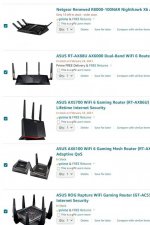Hello All:
I currently have a Nighthawk R8000. My speeds no matter what firmware I've tried, are capped at ~95 mbps both wired and wireless testing, whereas I'm getting ~470 at the modem. I've pretty much exhausted everything else I could think of, so I'm now looking to buy a new router. I have a two story home with basement, and large yard with decks and outside seating. We have 6 TVs all streaming wirelessly, 10 Sonos, 2 gaming children, and 2 working from home adults. I work in the Tech field, so I know enough to get me into trouble. With so many devices, I liked having a tri band router to divide the bandwidth usage, so when I began to look at Asus, I naturally looked at the RT-AC5300, then was trying to decide between that and the GT-AC5300. But the more I read from previous threads covering these two routers, seems like alot of people go something else like AX86U or something else dual band. I'm also trying to learn about the AX6100 but I can't even find it on Asus' website. I don't know anything about AX other than it's new. It seems all the routers are capable of AImesh, so that doesn't seem to be a determining factor. I don't really want cost to be a consideration at this point. I'm just wanting to figure out what makes the most sense for our family and our home. Can I get some assistance in determining which router that would be? TIA.
I currently have a Nighthawk R8000. My speeds no matter what firmware I've tried, are capped at ~95 mbps both wired and wireless testing, whereas I'm getting ~470 at the modem. I've pretty much exhausted everything else I could think of, so I'm now looking to buy a new router. I have a two story home with basement, and large yard with decks and outside seating. We have 6 TVs all streaming wirelessly, 10 Sonos, 2 gaming children, and 2 working from home adults. I work in the Tech field, so I know enough to get me into trouble. With so many devices, I liked having a tri band router to divide the bandwidth usage, so when I began to look at Asus, I naturally looked at the RT-AC5300, then was trying to decide between that and the GT-AC5300. But the more I read from previous threads covering these two routers, seems like alot of people go something else like AX86U or something else dual band. I'm also trying to learn about the AX6100 but I can't even find it on Asus' website. I don't know anything about AX other than it's new. It seems all the routers are capable of AImesh, so that doesn't seem to be a determining factor. I don't really want cost to be a consideration at this point. I'm just wanting to figure out what makes the most sense for our family and our home. Can I get some assistance in determining which router that would be? TIA.


